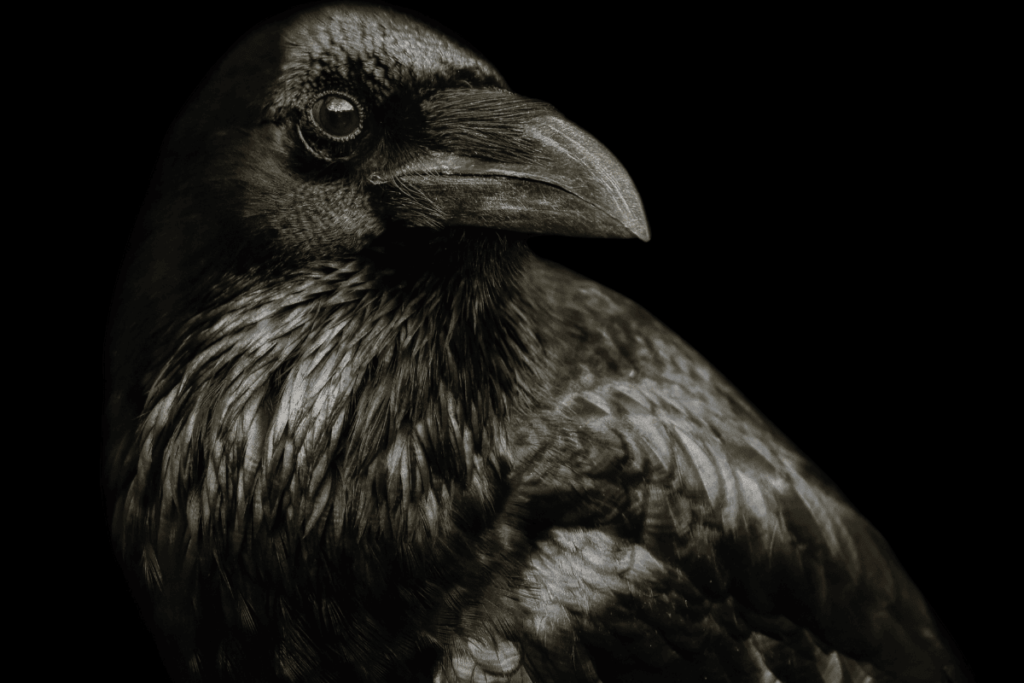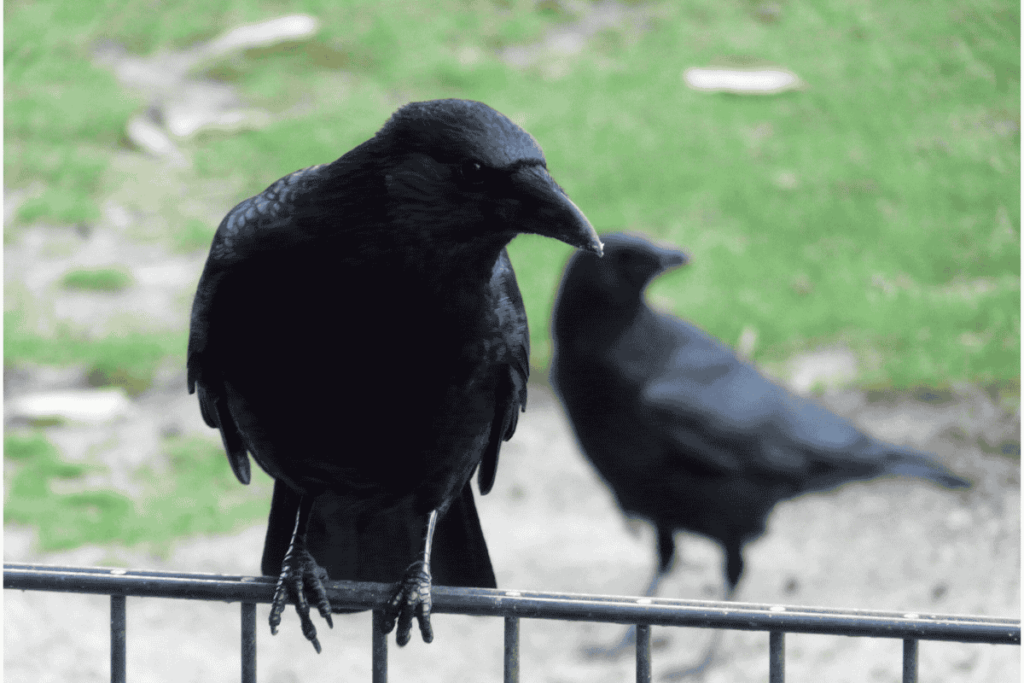You’re not alone if you’ve ever watched a clever crow scavenging your garden and wondered about its lifespan. In the wild, most crows barely make it to a decade. For example, American crows often only reach about 7–8 years, and even their European cousins, like hooded crows, live roughly 7–9 years on average. Carrion crows (common in the UK and Europe) average only 4–7 years (though some lucky individuals hit double digits). In other words, under natural conditions, crows generally live less than 10 years, often much less if they face early dangers.
However, in protected or captive settings, their lifespan can skyrocket. With steady food, no predators, and medical care, crows have lived 20, 30 or even 50+ years. The famous record is a captive American crow that allegedly lived to 59 years. We’ll dive into the numbers below.

How Long Do Crows Live in the Wild?
In the wild, a crow’s life is full of perils. Most adult crows only live a few years:
- Average lifespan: Roughly 7–8 years for American crows; about 4–7 years for European carrion crows (some reports note up to ~10 years for mature ones).
- Early mortality: About half of all young crows die within their first year, which drags the average way down. Predators (hawks, owls, eagles) and accidents (cars, falls) take out many chicks and fledglings.
- Survivors: If a crow survives its risky youth, it often lives into its early teens. The absolute oldest wild American crow recorded was 17 years and 5 months old. But that’s an extreme case – very few crows ever reach their late teens in nature.
A hooded crow on a fencepost. In the wild, crows like this seldom live past 10 years unless they dodge predators and accidents.
Why Such Short Lives?
Wild crows face many challenges:
- Predators and nest threats: Eggs and chicks get eaten by snakes, raccoons, ravens, magpies, or other crows. Adults can be hunted by large birds of prey or even ground predators like coyotes and cats.
- Human-related hazards: Many are killed by cars or collisions. People sometimes poison or trap crows seen as pests. Habitat destruction also reduces safe nesting spots.
- Disease: Crows are highly susceptible to viruses like West Nile, which has wiped out large portions of populations. Other avian diseases and parasites also take a toll.
- Environment and weather: Harsh winters or storms can kill young or weaken adults. Starvation is a risk if food becomes scarce.
Because of all this, most crows never see old age. Some studies suggest that up to 89% of crows fail to reach breeding age (around 2–4 years). Simply surviving infancy gives a crow a much better shot at longevity.
Crows do have one advantage: they live in family groups. Often, young crows stick around and help raise siblings, which can slightly boost survival for the group. But even with teamwork, the usual wild crow lifespan is under 10 years. Learn more about The Significance of Crows and what they represent.

How Long Do Crows Live in Captivity?
Crows in captivity – such as in zoos, aviaries, or rehabilitation centres – live much longer. Remove the dangers and give them good food and care, and their life expectancy roughly doubles or triples. For instance:
- American crows in captivity commonly exceed 25 years. Many live 30+ years with proper care.
- Carrion crows (European types) have been recorded to live 20 years or more under human care.
- Extreme record: One famous captive crow (named “Tata”) was said to have lived 59 years. Learn more about “Tata” , the crow. Ornithologists are skeptical of that claim, but it shows the potential: clearly, crow genetics can allow for very long lives.
Why the Big Jump?
In captivity:
- No predators: Enclosures keep hawks, owls and cats away.
- Steady diet: Crows get regular high-quality food year-round. For more on crows diet explore: What Do Crows Like to Eat.
- Medical care: Injuries or diseases can be treated by vets.
- Shelter: They’re protected from extreme weather.
- Enrichment: Keepers give crows puzzles and toys. These smart birds even use tools and solve problems when engaged.
All these factors mean a captive crow can easily reach 3–5 times the age of its wild cousins.
Species Comparison
Not all “crows” are the same, so lifespans vary by species:
- American Crow (Corvus brachyrhynchos): ~7–8 years in the wild; 25+ in captivity. Oldest wild ~17 years.
- Carrion Crow (Corvus corone): Wild ~4–7 years (some live ~10+); in captivity ~20 years.
- Hooded Crow (Corvus cornix): Wild ~7–9 years; can live 20+ in safe captivity.
- Common Raven (Corvus corax): Wild ~10–15 years; can exceed 40 years in captivity.
- Jackdaws, magpies, rooks, jays: Smaller corvids generally live shorter lives (~5–10 years wild). Rooks are similar to carrion crows.
The pattern: bigger corvids tend to live longer, and protected birds live longer than wild ones.
Other Factors Affecting Lifespan
Besides predator avoidance, a crow’s environment and lifestyle play a role:
- Food and nutrition: Good nutrition helps crows live longer.
- Climate and habitat: Mild areas with abundant food promote longer lifespans. Urban crows face more dangers despite easy food.
- Social support: A strong family group improves chick survival and early life success.
- Diseases and toxins: Outbreaks like avian flu or exposure to toxins (lead, pesticides) can sharply reduce lifespans.
- Genetics: Some individual crows are naturally built to live longer.
In essence, wild crows are more likely to die from external causes than from old age. If a crow manages to dodge every hazard, it might eventually die of natural aging – but that’s rare.
FAQ
How long do wild crows usually live?
Wild crows rarely reach 10 years. American crows average about 7–8 years. In Europe, carrion crows live around 4–7 years in the wild.
How long can captive crows live?
In captivity, crows often reach 20–30+ years. Many American crows live past 25 years. Some records claim 30–50 years.
What is the oldest recorded age of a crow?
The oldest wild crow recorded was about 17 years and 5 months old. The oldest captive crow was reportedly 59 years, though that number is debated.
Why do many crows die young?
Most die from external factors. Nearly half die in their first year due to predators, starvation, or accidents. Adults face cars, poisons, disease, and more predators.
Can crows die of old age?
Eventually, yes – but it’s rare in the wild. Without predators or illness, a crow’s body can age and fail after a couple of decades.
What affects how long a crow lives?
Many things: species, genetics, environment, access to food and shelter, social factors, and whether it lives in the wild or in captivity.
In summary, how long do crows live? Wild crows usually live under 10 years, whereas crows in captivity can often live 20–30 years or more. The exact number depends on species and conditions – but now you have the full picture.
